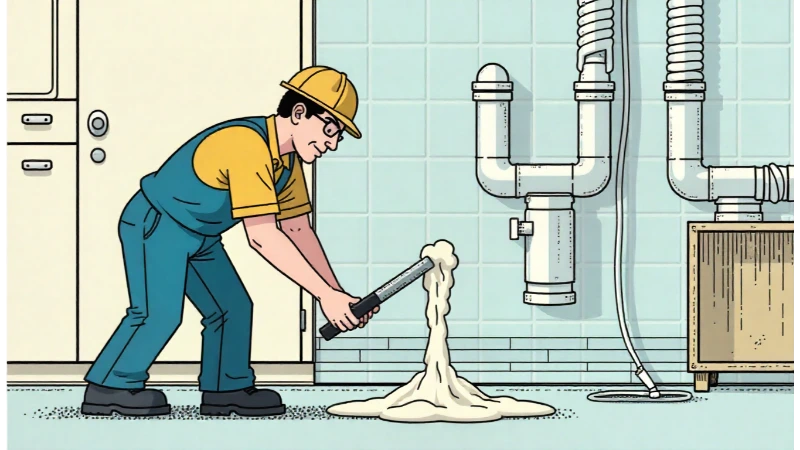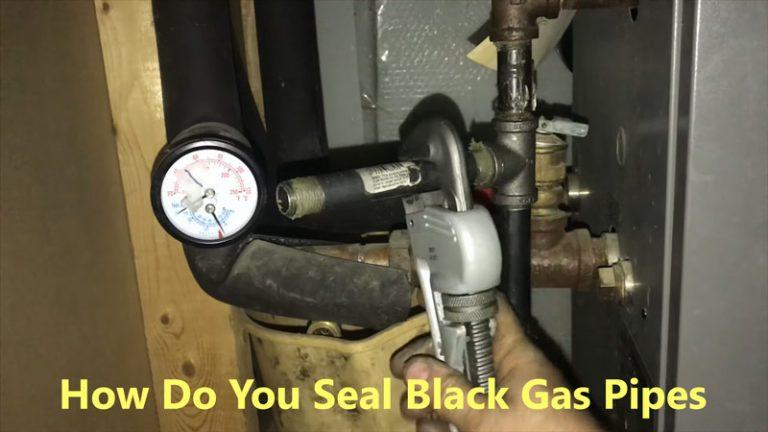How to Clean Pipe Dope: The Ultimate Guide to a Mess-Free Job
Pipe dope, also known as thread sealant, is a plumber’s best friend and a DIYer’s occasional nightmare. It’s essential for creating a watertight, leak-proof seal on threaded pipe joints. However, its sticky, tenacious nature means it can get everywhere: on your hands, your tools, your clothes, and your workspace.
The frustration of trying to wipe away this stubborn paste is a common experience. If you’ve ever finished a plumbing job only to find a sticky, messy residue that refuses to budge, you know the struggle. This guide provides a comprehensive, step-by-step solution to this messy problem.
You'll Learn About
Why Is Pipe Dope So Hard to Clean?
Understanding what makes pipe dope so difficult to remove is the first step to conquering it. The very properties that make it an excellent sealant also make it a formidable cleaning challenge. It is designed to be incredibly resilient.
Most pipe dopes are a compound of oils, solvents, and solid fillers like PTFE (Teflon) or other minerals. This formulation makes it waterproof, resistant to chemicals, and incredibly sticky to ensure it stays in the threads. When it dries, it cures into a hardened, semi-flexible plug that is tough to dissolve.
Essential Tools and Safety Precautions
Before you begin, gathering the right supplies will make the job faster and more effective. You don’t need a lot, but having the correct items on hand is crucial. Proper preparation prevents frustration later.
You will need clean, lint-free rags, paper towels, a stiff nylon bristle brush, and appropriate personal protective equipment (PPE). Always wear chemical-resistant gloves and safety glasses when working with solvents. Good ventilation is also non-negotiable to avoid inhaling fumes.
How to Clean Pipe Dope from Hands and Skin
Getting pipe dope on your hands is almost unavoidable. Trying to wash it off with just soap and water is often a useless, sticky endeavor. The key is to use a substance that can break down the oily base of the sealant.
First, wipe off as much of the excess dope as possible with a dry paper towel. Then, use an oil-based or citrus-based mechanic’s hand cleaner like Gojo or Fast Orange. Lather the cleaner on your dry hands, working it into the sticky areas, then rinse thoroughly with soap and water.
If you don’t have a specialized hand cleaner, a common household oil can work in a pinch. Apply a small amount of mineral oil, vegetable oil, or even olive oil to your skin and rub it in to dissolve the sealant before washing with soap.
Cleaning Pipe Dope from Pipe Threads and Fittings
The most important place to clean pipe dope is from the pipe fittings themselves, either to neaten up a new joint or to prepare an old one for reassembly. The method depends entirely on whether the dope is still wet or has fully cured.
Cleaning Wet Pipe Dope from Threads
Cleaning up immediately after application is the easiest scenario. The goal is to remove the excess that has squeezed out of the joint. This creates a professional-looking finish and prevents the mess from spreading.
Simply take a clean, dry rag and wipe firmly around the joint to remove the squeezed-out sealant. For a perfectly clean look, you can lightly dampen a separate rag with mineral spirits and give the fitting a final wipe-down. Be careful not to use too much solvent, as you don’t want to compromise the fresh seal.

Tackling Dried and Cured Pipe Dope
Removing old, hardened pipe dope is a more involved process that requires patience and some elbow grease. This is a critical step when disassembling and re-sealing a joint. You must remove all old material for the new sealant to work correctly.
Start with mechanical removal. Use a stiff nylon bristle brush—not a wire brush, which can damage the threads on softer metals like brass—to scrub the threads. The goal is to break off as much of the brittle, dried dope as possible before using chemicals.
Next, apply a solvent to break down the remaining residue. Mineral spirits are an excellent starting point as they are effective yet less harsh than other options. Apply the solvent with a rag or brush and let it sit for a few minutes to penetrate the old dope.
After letting the solvent work, scrub the threads again with your nylon brush to agitate and lift the softened sealant. Wipe the threads clean with a rag. You may need to repeat this process a few times to remove all traces of the old compound.
Ensuring threads are completely clean is vital for a secure connection, especially in critical applications. For example, when you learn how do you seal black gas pipes, you’ll find that perfectly clean threads are the foundation of a safe, leak-free joint.
Removing Pipe Dope from Different Surfaces
Accidents happen, and pipe dope can easily end up on floors, workbenches, or clothing. The cleaning method will vary significantly depending on the surface material. Always test any solvent on a small, inconspicuous area first to ensure it won’t cause damage or discoloration.
Cleaning Pipe Dope from Clothing and Fabrics
Finding a smear of pipe dope on your clothes is frustrating, but it’s not always a lost cause if you act quickly. First, use a dull knife or spoon to gently scrape off any excess sealant. Be careful not to press it deeper into the fabric.
Apply a small amount of a solvent like rubbing alcohol or a citrus-based degreaser to a clean cloth and blot the stain. Do not rub, as this can spread the stain. Continue blotting with a clean section of the cloth until the dope is lifted. Treat the remaining spot with a pre-wash stain remover and launder as usual.
Cleaning Pipe Dope from Floors and Workbenches
For hard, non-porous surfaces like a metal workbench, finished wood, or vinyl flooring, the process is straightforward. Scrape off the excess, then use a rag dampened with mineral spirits or a citrus cleaner to wipe away the residue. Clean the area with a standard surface cleaner afterward.
Porous surfaces like concrete or unfinished wood are more challenging as the oils can seep into the material. For these, you can create a poultice by mixing an absorbent material like kitty litter or sawdust with a solvent to form a paste. Spread the paste over the stain, let it dry, and then sweep it away. This helps draw the stain out of the pores.
The table below provides a quick reference for choosing the right cleaning agent for your task.
| Cleaner/Solvent | Best Use Case | Pros | Cons |
|---|---|---|---|
| Mineral Spirits | Metal threads, tools, non-porous surfaces | Effective, relatively mild | Flammable, requires ventilation |
| Acetone | Stubborn dried dope on metal (use with care) | Very strong, evaporates quickly | Can damage plastics, paint, and finishes |
| Denatured Alcohol | General cleaning, less aggressive than acetone | Less harsh than acetone, effective | Flammable, can dry out some materials |
| Citrus-Based Cleaners | Hands, painted surfaces, floors | Biodegradable, less toxic fumes | May be less effective on very cured dope |
| Oil-Based Hand Soap | Skin and hands | Specifically designed for grease and grime | Not suitable for cleaning parts or surfaces |
Pro Tips for Preventing Pipe Dope Messes
The best way to deal with a pipe dope mess is to prevent it from happening in the first place. Adopting a few clean work habits can save you a significant amount of cleanup time. A tidy application is the mark of a skilled professional.
First, always apply the dope only to the male threads of the pipe. Second, start the application on the second or third thread from the end. This prevents the sealant from being pushed inside the pipe when you tighten the fitting, which can clog valves or fixtures.
Remember that less is more. You only need enough sealant to fill the root of the threads, not a thick coating. Over-application is the number one cause of messy squeeze-out. Keep a dedicated “dirty” rag handy to immediately wipe away any excess.
Frequently Asked Questions (FAQ)
Even with a detailed guide, specific questions often arise. Here are answers to some of the most common queries about cleaning pipe dope, helping you tackle any situation with confidence.
Do I need to clean old pipe dope off before reapplying?
Yes, absolutely. This is one of the most critical steps in plumbing. Leaving old, hardened, or contaminated dope on threads will prevent the new sealant from creating a perfect seal. This can lead to slow, persistent leaks that are difficult to diagnose.
Failing to properly clean threads is a common cause of joint failure. This principle is especially important if you are trying to learn how to fix leaking threaded joint without cutting, as a pristine surface is your best chance for success.
Can I use gasoline or brake cleaner to remove pipe dope?
While these aggressive solvents might seem like a quick fix, they should be avoided. Gasoline and chlorinated brake cleaners are extremely flammable and their fumes are highly toxic and hazardous to your health. Stick with safer, recommended alternatives like mineral spirits, denatured alcohol, or citrus-based degreasers.
Will pipe dope dissolve on its own over time?
No, it will not. Pipe dope is engineered for longevity and resistance to water, gas, and other chemicals. It will harden and cure over time, but it will not dissolve or break down on its own. It must be mechanically and chemically removed.
Conclusion: A Clean Job is a Professional Job
Cleaning pipe dope doesn’t have to be a frustrating chore. By understanding its properties and using the right tools and techniques, you can easily manage any mess, whether it’s on your hands, your workpiece, or your clothes. Remember to always prioritize safety by using gloves and ensuring proper ventilation.
From simple repairs to more involved projects like a DIY patio heater conversion, mastering these cleaning skills will elevate the quality and professionalism of your work. By following these steps and focusing on a clean application from the start, you can make sticky pipe dope messes a thing of the past.

